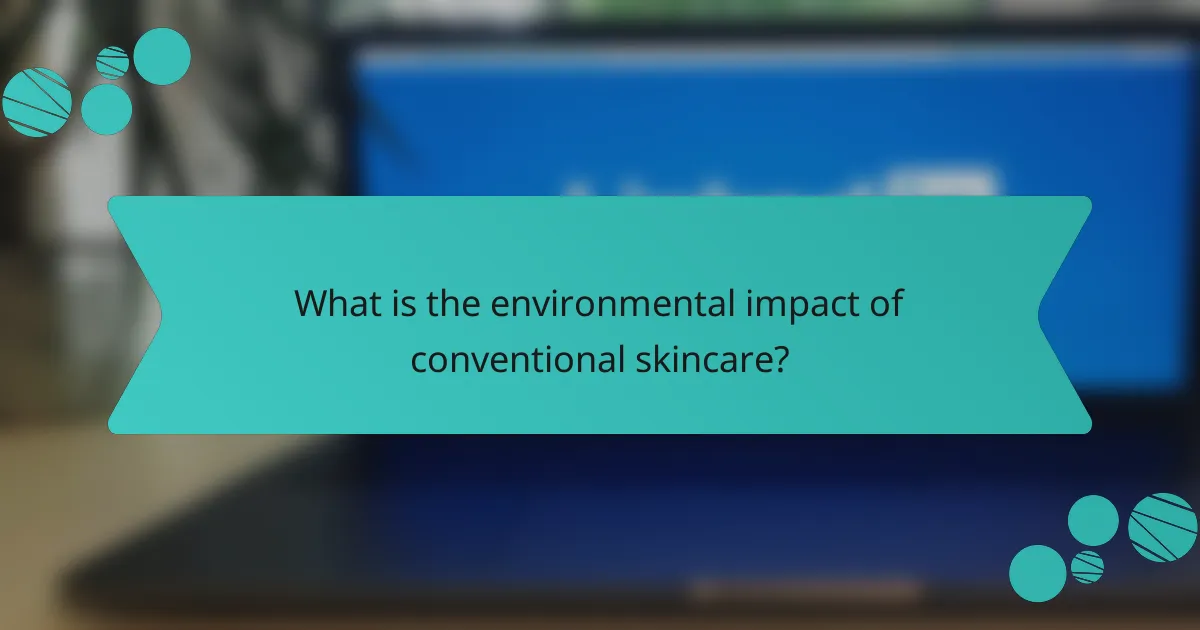Adopting an eco-friendly skincare routine allows you to prioritize both your skin health and the environment. By selecting sustainable products made from natural ingredients and packaged responsibly, you can significantly reduce your ecological footprint. Embracing these choices not only benefits your skin but also supports ethical practices in the beauty industry.

How to create an eco-friendly skincare routine in the UK?
Creating an eco-friendly skincare routine in the UK involves selecting products that are sustainable, made from natural ingredients, and packaged responsibly. By making informed choices, you can reduce your environmental impact while caring for your skin.
Use sustainable brands like Lush and The Body Shop
Choosing sustainable brands is crucial for an eco-friendly skincare routine. Brands like Lush and The Body Shop prioritize ethical sourcing, cruelty-free practices, and environmentally friendly production methods. They often use ingredients that are not only good for your skin but also for the planet.
When selecting products, look for certifications such as Fair Trade or organic labels, which indicate a commitment to sustainability. Supporting these brands can help promote wider industry changes towards more responsible practices.
Incorporate natural ingredients such as aloe vera and shea butter
Natural ingredients are a cornerstone of eco-friendly skincare. Ingredients like aloe vera and shea butter are not only effective but also biodegradable and less harmful to the environment. They provide nourishment and hydration without the synthetic chemicals found in many conventional products.
When shopping, check the ingredient list for natural options and avoid products with parabens, sulfates, and artificial fragrances. This not only benefits your skin but also reduces the chemical load on the environment.
Choose refillable or recyclable packaging options
Opting for refillable or recyclable packaging is essential for minimizing waste in your skincare routine. Many brands now offer refill stations or reusable containers, which can significantly reduce plastic waste. Look for products packaged in glass, metal, or biodegradable materials.
To make a positive impact, consider implementing a recycling system at home for your empty skincare containers. Always check local recycling guidelines to ensure proper disposal and contribute to a more sustainable future.

What are the benefits of eco-friendly skincare?
Eco-friendly skincare offers numerous benefits, including a reduced environmental footprint and improved skin health. By choosing sustainable products, consumers can support ethical practices while enjoying the advantages of natural ingredients.
Reduces environmental impact
Eco-friendly skincare products are designed to minimize harm to the environment. They often use biodegradable ingredients and sustainable packaging, which helps reduce waste and pollution.
For example, brands that utilize recyclable or compostable materials for their packaging contribute to a circular economy. Choosing products with minimal packaging can further lower your ecological footprint.
Promotes healthier skin
Natural ingredients in eco-friendly skincare are typically gentler on the skin compared to synthetic chemicals. These products often contain fewer irritants, making them suitable for sensitive skin types.
Common natural ingredients like aloe vera, shea butter, and essential oils can nourish and hydrate the skin without harmful side effects. Opting for products free from parabens and sulfates can lead to healthier, more radiant skin over time.
Supports ethical sourcing and fair trade
Many eco-friendly skincare brands prioritize ethical sourcing, ensuring that ingredients are harvested sustainably and responsibly. This practice supports local communities and promotes fair labor conditions.
When selecting skincare products, look for certifications such as Fair Trade or organic labels. These indicators can help you choose brands that align with your values and contribute positively to the environment and society.

Which natural ingredients are best for skincare?
Natural ingredients for skincare are often chosen for their effectiveness and minimal environmental impact. Ingredients like jojoba oil, tea tree oil, and vitamin E stand out for their specific benefits, making them popular choices in eco-friendly routines.
Jojoba oil for hydration
Jojoba oil is an excellent moisturizer that closely resembles the skin’s natural oils, making it highly effective for hydration. It penetrates the skin easily, providing moisture without clogging pores, which is ideal for both dry and oily skin types.
When using jojoba oil, a few drops can be applied directly to the skin or mixed with other products. Look for organic, cold-pressed varieties to ensure quality and sustainability.
Tea tree oil for acne treatment
Tea tree oil is renowned for its antibacterial and anti-inflammatory properties, making it a powerful natural remedy for acne. It helps reduce the size of pimples and prevents future breakouts by targeting the bacteria that cause acne.
To use tea tree oil, dilute it with a carrier oil, such as jojoba or coconut oil, before applying it to the affected areas. This prevents irritation and enhances its effectiveness. Always perform a patch test to avoid adverse reactions.
Vitamin E for skin repair
Vitamin E is a potent antioxidant that plays a crucial role in skin repair and protection. It helps to neutralize free radicals, which can damage skin cells and accelerate aging, making it essential for maintaining healthy skin.
Incorporating vitamin E into your skincare routine can be done through topical application of oils or serums rich in this nutrient. Look for products that contain natural sources of vitamin E, such as wheat germ oil or sunflower oil, to maximize benefits.

How to choose eco-friendly skincare products?
Choosing eco-friendly skincare products involves selecting items that prioritize sustainability, natural ingredients, and minimal environmental impact. Look for brands that align with these values to ensure your skincare routine is both effective and responsible.
Look for certifications like cruelty-free and organic
Certifications such as cruelty-free and organic indicate that a product meets specific ethical and environmental standards. Cruelty-free products are not tested on animals, while organic items are made from ingredients grown without synthetic pesticides or fertilizers.
When shopping, check for labels from recognized organizations like the USDA Organic or Leaping Bunny. These certifications help you make informed choices and support brands committed to ethical practices.
Check ingredient transparency and sourcing
Ingredient transparency means that brands openly disclose all components in their products, allowing consumers to understand what they are applying to their skin. Look for brands that provide detailed information about ingredient sourcing, including whether they use sustainable or local sources.
Prioritize products with natural ingredients, avoiding those with synthetic additives or harmful chemicals. A good rule of thumb is to choose items with a short ingredient list, as this often indicates fewer artificial components.

What is the environmental impact of conventional skincare?
Conventional skincare products often have a significant negative impact on the environment due to their production processes, packaging waste, and harmful chemicals. These factors contribute to pollution, resource depletion, and ecosystem damage.
High carbon footprint from production
The production of conventional skincare items typically involves energy-intensive processes that result in a high carbon footprint. Ingredients are often sourced from distant locations, increasing transportation emissions. Choosing local and sustainably sourced ingredients can help reduce this impact.
Additionally, many conventional products rely on synthetic ingredients derived from fossil fuels, which further contributes to greenhouse gas emissions. Opting for brands that prioritize renewable resources can mitigate this effect.
Plastic pollution from packaging
Conventional skincare products frequently use plastic packaging, which contributes significantly to global plastic pollution. Many of these containers are single-use and end up in landfills or oceans, where they take hundreds of years to decompose.
To combat this issue, consumers can look for brands that utilize recyclable or biodegradable packaging. Supporting companies that offer refillable options can also greatly reduce plastic waste.
Chemicals harming ecosystems
Many conventional skincare products contain synthetic chemicals that can be harmful to aquatic and terrestrial ecosystems. Ingredients like parabens, sulfates, and microbeads can disrupt marine life and contaminate water sources.
Choosing products with natural and organic ingredients can help minimize this risk. Look for certifications such as “eco-friendly” or “biodegradable” to ensure that the products are less likely to harm the environment.

How to transition to an eco-friendly skincare routine?
Transitioning to an eco-friendly skincare routine involves gradually replacing conventional products with sustainable alternatives that prioritize natural ingredients and minimal environmental impact. Start by evaluating your current products and making informed choices that align with eco-conscious principles.
Start with one product at a time
Begin your eco-friendly transition by focusing on one product, such as your cleanser or moisturizer. This approach allows you to assess the effectiveness of the new product without overwhelming your routine.
Choose a product that you use daily and is easy to replace with a sustainable option. For instance, if you typically use a conventional moisturizer, look for one that is certified organic or has eco-friendly packaging.
Research brands and their sustainability practices
Investigate brands to understand their commitment to sustainability, including sourcing, production methods, and packaging. Look for certifications like USDA Organic or cruelty-free labels that indicate responsible practices.
Check for transparency in ingredient sourcing and whether the brand supports ethical labor practices. A brand that prioritizes sustainability will often provide detailed information about their environmental impact and efforts to reduce waste.
